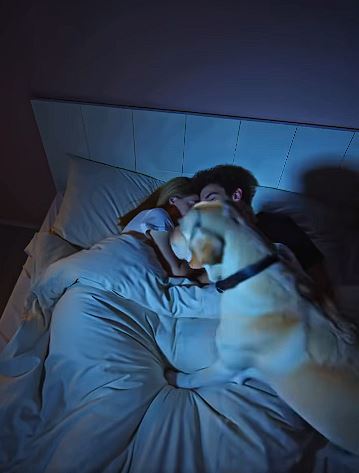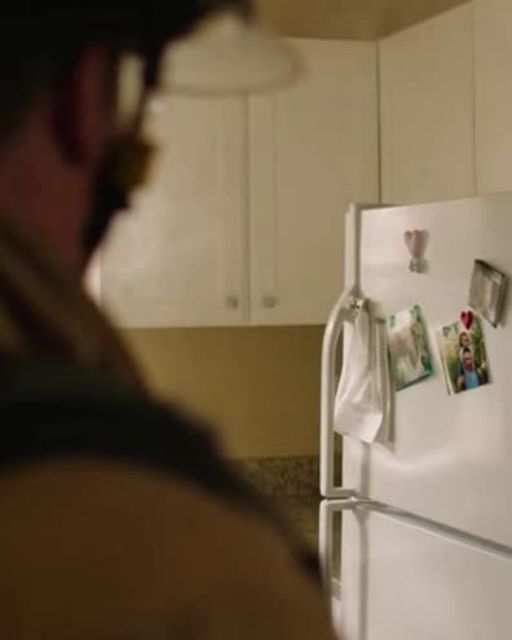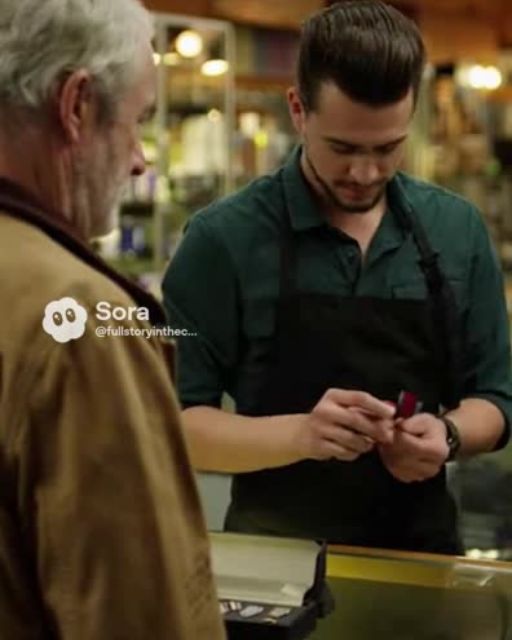It was a night like any other. My wife and I were sleeping in our bedroom, wrapped in the duvet. Our six-year-old boy and our one-year-old girl were sleeping in their rooms a long time ago. Quiet, calm—nothing announced any disaster.
The clock showed around three in the morning when our Labrador, Sami, suddenly entered the bedroom. He has been with us for eight years—an intelligent, gentle dog, a real member of the family. He never got us into trouble, always knew how to behave inside the house. But that night, it was different.
Sami rushed to the bed on my wife’s side, put his paws on her chest, and slowly started barking. Immediately, his behavior caught me off guard. I had strictly forbidden him from getting on the bed, and he always understood. But now, he was acting weird and scary.
I suddenly woke up, heart beating insanely—in the middle of the darkness I saw the dog sitting on top of my wife. For a split second, I panicked: what’s going on? But then I suddenly understood what was happening and immediately dialed the emergency number.
My wife, Narelle, wasn’t breathing normally. It was shallow, almost silent. Her skin looked oddly pale under the dim hallway light. Sami was pressing on her chest gently but persistently, his bark low but consistent. He wasn’t panicking—he was alerting.
While waiting for the ambulance, I shook her gently. “Narelle! Narelle, can you hear me?” Her eyelids fluttered, but she didn’t speak. Her lips were slightly bluish. That’s when the terror really kicked in.
Sami stayed on her side the whole time. When the paramedics arrived, they confirmed what I feared: she was having a silent cardiac episode. Not a full-blown heart attack, but her oxygen levels were dangerously low, and her heart was under strain. They told me, straight-up, if I hadn’t called when I did—if the dog hadn’t intervened—she might not have woken up at all.
At the hospital, they stabilized her. Turns out it was a rare condition called “nocturnal hypoxemia” linked to an undiagnosed form of sleep apnea and a pre-existing heart rhythm irregularity. She had probably had symptoms for months but shrugged them off as anxiety or exhaustion from parenting two little ones.
The next day, while she rested, I brought Sami in for a visit. Narelle cried seeing him. She couldn’t speak much, but she hugged his neck so tight I thought he’d whimper. But he didn’t. He just stood there, calm and proud.
For the next few weeks, we reevaluated everything. I took time off work. We had long talks—real, raw ones. About the pace of our lives. About how we’d ignored the signs. About how close we came to losing everything.
The first twist came a week later.
Our son, Arlen, quietly came to me and said, “Dad, Sami barked at Mom before.” I asked him what he meant. He explained that sometimes, when I wasn’t around, Sami would nudge her chest or stare at her while she was napping. She always thought it was cute, even joked about it.
That knocked the wind out of me. Sami had noticed something long before we did. Dogs are intuitive, sure—but this wasn’t just instinct. It was loyalty. Almost like… he’d been trying to tell us something all along.
We scheduled a full medical screening for Narelle. That’s when we learned the condition was genetic—silent in her mother’s side, which had a history of “night strokes” and unexplained fainting. If Sami hadn’t intervened, it would have gone unnoticed for years—possibly until it was too late.
Narelle began treatment immediately. A nighttime breathing machine, some medications, lifestyle changes. Nothing extreme, but life-altering all the same. She began taking daily walks with Sami, letting herself rest more, saying no to things she used to take on without question. I saw a peace in her I hadn’t noticed in years.
But that wasn’t the end of it.
Three months later, Narelle asked me to take Sami in for a vet visit. He had started sleeping more and eating a bit less. No big deal—we thought it was maybe the change of season, or just age catching up. He was almost nine.
The vet, however, had another opinion. A tumor. Not very large yet, but on his spleen. Benign, maybe. Maybe not.
We were crushed.
The vet said we could operate, but it came with risks. Narelle didn’t hesitate. “He saved my life. He gave me more time with our kids. We owe him that much.”
So we went through with the surgery. It was expensive, and honestly, it was tough financially. But I never doubted the decision. I remembered the sound of Sami’s bark that night—the way he stayed by her side.
The operation went well. The tumor was benign. Sami bounced back better than we expected. He was slower, sure. But he was still our Sami.
One morning, a few weeks later, Arlen came into our room with his art project from school. He’d drawn a picture of our family—Mom, Dad, baby Rina, and Sami—in superhero capes. Above it, in big blue letters, he wrote: “My dog saved my mom because he’s not just a dog—he’s love.”
I’ll be honest, I cried a little. Maybe more than a little.
That picture now hangs in our hallway. Right next to a photo we took of Sami on his 9th birthday, wearing a ridiculous paper crown and eating a special peanut butter treat.
But the story doesn’t end there either.
A few months later, Narelle, now volunteering at a local women’s support group, met someone named Fariha. A mother of two who was going through a tough time—divorce, no family nearby, and no real help. She had an old dog, too. One she couldn’t afford to care for anymore.
I watched as Narelle quietly covered the vet expenses for that dog. Didn’t tell anyone. Just said, “Someone once saved me. I’m just returning the favor.”
That hit me in a way I didn’t expect. We always say we love our pets like family, but I don’t think I understood what that meant until all this happened. Sami didn’t just save a life—he started a ripple. A whole chain of events that shifted how we live, how we love, how we give.
And the final twist? We found out a few weeks ago that the medical alert dog training program we donated to in Sami’s name after the surgery—just a modest donation—used those funds to train a dog for a teenage girl with epilepsy. The trainer sent us a photo: the dog was a young Labrador, just like Sami, with golden fur and kind eyes. His name was Hope.
It felt like a full circle. Like somehow, what started as a terrifying moment in the middle of the night became a bigger story of grace.
Now, every night before we sleep, Sami lies at the foot of our bed. He’s slower now, more careful with his steps, and his muzzle has gone almost completely white. But we don’t treat him like an old dog. We treat him like the hero he is.
And here’s the life lesson we carry now: Sometimes the quietest signals are the ones that matter most. Sometimes love shows up not with words, but with a nudge, a bark, a silent presence when things fall apart.
We nearly missed the signs. But love—real, persistent love—doesn’t give up that easily.
So if you’ve got someone or something in your life sending little signs… stop. Listen. You never know what it could mean.
And if you’ve got a Sami of your own, give them an extra treat tonight. They deserve it more than we know.
If this story touched you, share it with someone you love—maybe they need a reminder that life gives second chances in the most unexpected ways. ❤️
👇
(share if you believe in second chances and the love of a loyal pet)




